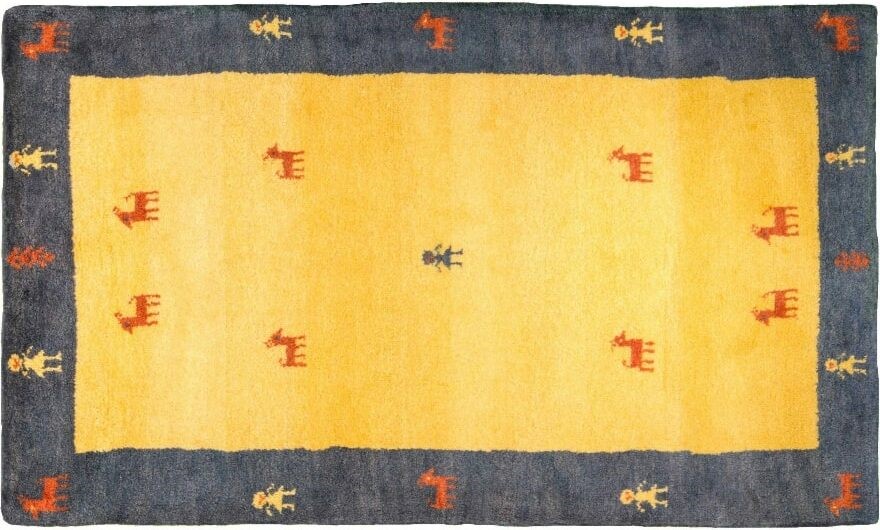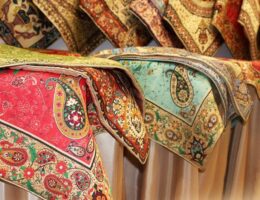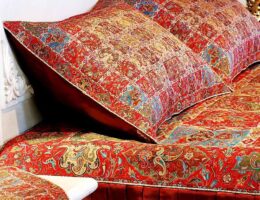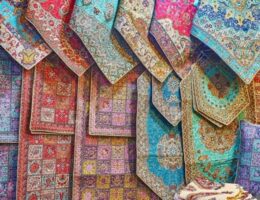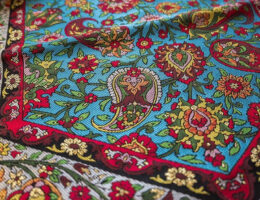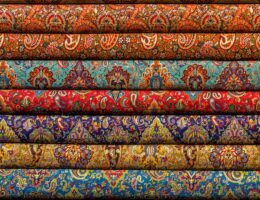IRAN ART EXHIBITION: GABBEH CARPET ALSO CAN BE USED IN MODEN DECOR
Gabbeh (or Gabba) is a Persian long-piled hand-knotted, with a thick and coarse but loose and flabby quality. Plus, some rugs are a bit shaggy, others somehow Kilim-like at first glance. These are the rugs that nomadic women weave for their own. The western markets found out about Gabbeh rug only in the recent five decades or so. They are also amongst the most vivacious ones within the Persian art of rug.
Gabbeh is a simple base for qâlis (the actually piled rugs), so its tradition is as old as the domestication of herds. The first reference to Gabbeh is in royal commands by Shah Tahmasp of the Safavid dynasty in the 16th century. The folks of the Zagros Mountains in Iran are the most celebrated tribal weavers of the Gabbeh rug.
The Story Behind Gabbeh Rugs
Gabbeh rug is the Persian pronunciation of “Gavva” in its native land. Gabbeh is to serve as a portable rug with several usages. Tribal people use Gabbeh in their daily life as ground cloth under tents or as mats, blankets, and even saddles.
In recent decades some Iranian artists and art collectors have focused on Gabbeh and introduced it to international markets. Gabbeh rug found its way rapidly in modern interior designs. Demands increased soon enough for China and India to start imitating. But mind! These rugs benefit not just by tradition but by all-natural dyes of Zagros and the creativity of every individual weaver.
Gabbeh rug has long piles, low knot density, and many rows of weft between each row of knots. The knotting can be either symmetrical or asymmetrical. The double-sided is a type of Gabbeh rug, for which two face-to-face weavers knit on a vertical loom between them. The weavers have to use the simplest of patterns for the double-sided Gabbeh rug. Wool is the usual raw material for them, but the weavers also use goat hair in some rugs. Some producers may use cotton, but it’s not the proper raw material for these tribal rugs.
Designs and Patterns of The Gabbeh Rug
The rug artisans usually produce Gabbeh rug antecedent designs. That is the key to their free abstraction of colors and geometrics and simple stylization of figures and representative shapes.
Typically, there is a minimal pattern with an occasional stick figure or simply stylized animals on a Gabbeh. Some Gabbeh rugs woven by Bakhtiaris and Qashqaeis have stylized figures of lions. This could be a large single one or some little ones. In some rugs, tiny simplified figures of humans, sheep, and camels spot the plain fields. Trees are also depicted frequently on these rugs, either as a single large icon or as tiny ones.
Xeshti or framed designs are also common, as well as striped designs. In Luri and Kurdish, Xersak means a little bear, and it is a special appellation used by Bakhtiari Lurs.
IRAN ART EXHIBITION: One could list lots of famous Zagros’ towns and rural and tribal areas: Sanandaj (Sanne), Nehavand, Bijar, Kabudarahang, Khorramabad, Borujerd, and Aligudarz in Kurdistan and Luristan. And downwards into the Fars where Qashqais emigrate, weaving the best Gabbeh rugs in both artistry and quality of raw materials. Zagros slopes into the Persian Gulf by the coastal Shur village, the furthermost place mentioned as a Gabbeh weaving center.
Technical Aspects and The Structure of The Gabbeh Rug
Nomads make genuine Gabbeh rugs for their own use. Practically, they should be handy and portable in nomadic everyday life. Therefore, medium or smile sizes are favored with loose texture to be folded and unfolded easily. These are also the favored sizes in contemporary decors in which the Gabbeh rug is much more popular.
Dyeing and Painting of Gabbeh Rug
The Gabbeh rug is woven with both dyed and undyed yarns making two distinct types of ‘colored’ and ‘natural’ Gabbeh rug. This includes shades of cream, white, grey, light and dark brown, and black, making cream or camel or grey fields.
In the case of dyed yarns, Gabbeh weavers feel free to use whatever they have. It depends on their sudden impressions, which is possible due to the plain nature of Gabbeh weaving. The results are mostly lively rugs with vivid coloring.
IRAN ART EXHIBITION: Gabbeh is a traditional flooring similar to carpet but they differ from one another in motifs, size, colors, and the number of its long and thick wefts. It is one of the most popular handicrafts in the southwestern province of Bushehr.
Gabbeh represents a rough and primitive carpet with patterns mostly made by nomadic people. They are manufactured by handspun wool, both in the pile and warp, and the yarns are dyed using plant dyes. The patterns of the carpet are of a simple type with only a few elements of decorative, mostly rectangular objects containing animals.
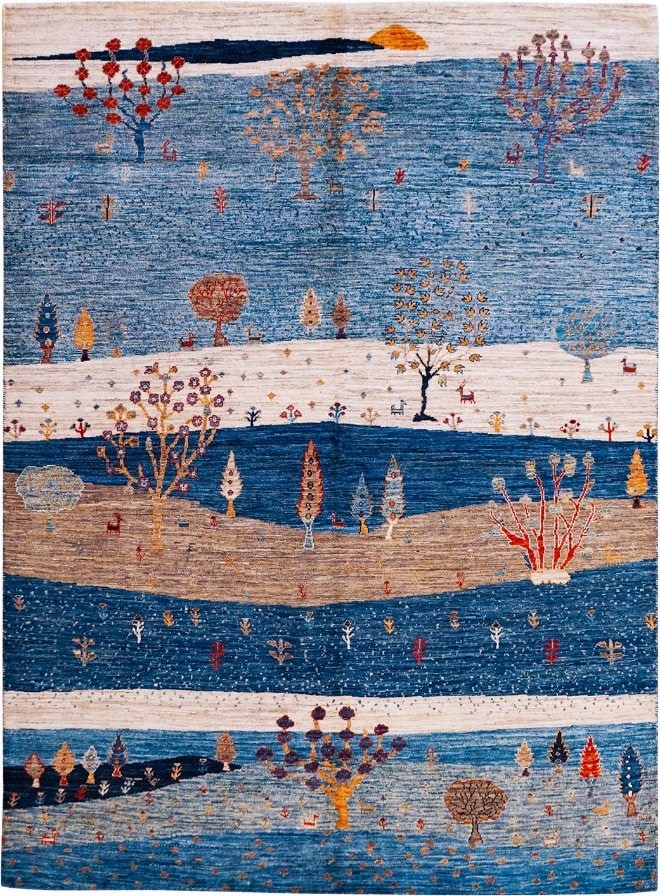
They are common in almost all the villages and even some of the cities of the southwestern province. The motifs and patterns of Gabbeh are not the same as the carpet. Gabbeh may do not have any margin, or may not be symmetrical. Many of its motifs look like paintings of children, quite simple and primitive, but inspired by nature and surroundings.
Patterns of Gabbeh are created by the memory of their weavers. They are completely free to use any motif and they can place it anywhere they desire in the pattern. Another major difference between Gabbeh and carpet is the color palette used in them.
A major part of the Gabbeh is weaved using wools in their raw color. The Bushehr Gabbeh has plain backgrounds in white, cream, brown, black, and grey, and the patterns are made in black, red, dark blue, and other similar colors.
IRAN ART EXHIBITION: The weavers are mostly women and girls who each have a special kind of motif on their minds and they skillfully weave them. In general, the common feature of the Gabbeh of Bushehr is the traditional patterns that have been evolved through generations and are artistically valuable.
The materials used in the process of Gabbeh weaving are produced from the wool of the sheep that are bred locally. Today European countries and the Arab states of the Persian Gulf are reportedly the two major buyers of Bushehr Gabbehs.
Therefore, the makers have begun dying the wool with herbal pigments such as orange, blue, green, and yellow to use them in the background. The motifs of these products are animals and doll-like.
Some of the most famous patterns are Langer (anchor), Khesht (brick), chang (harp), geometric forms, birds and animals, and kinds of paisley motifs. Bushehr Gabbehs are made in villages such as Shoul, Kamali, Bahmanyari, Mohammad Salehi, Sakhareh, Zakariyayi, Bamonir, Mal Mahmoud, Khalifehee, Otaybeh, Dehdaran, etc.
The coastal province borders with the Persian Gulf on the west and bounded by the regions of Hormozgan and Fars on the southeast and east and Khuzestan on the northwest.
